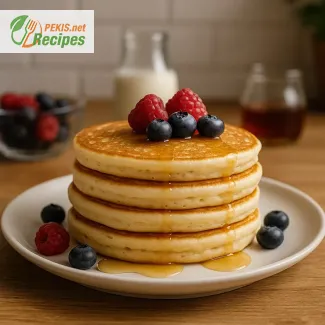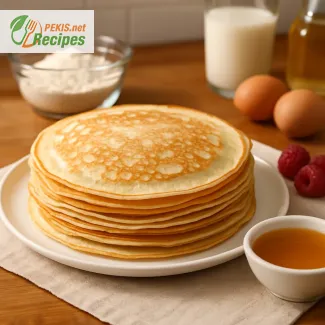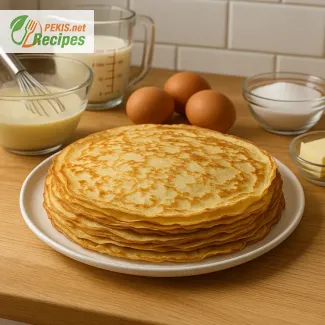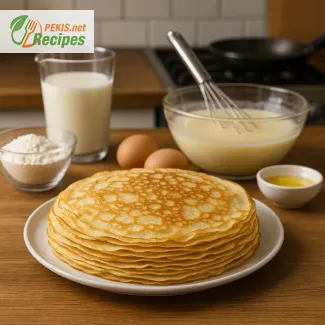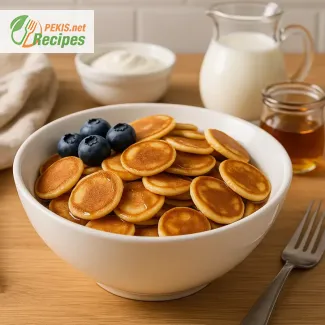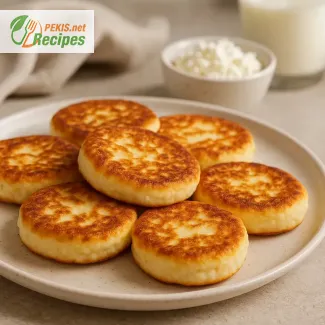
Discover the Secret to Perfectly Fluffy Cottage Cheese Pancakes
High-Protein Breakfast Delight Inspired by Eastern European Tradition
Cottage cheese pancakes, also known as Syrniki, are a time-honored breakfast dish originating in Eastern Europe, celebrated for their delightful texture and rich flavor. What sets these pancakes apart from traditional varieties is their use of cottage cheese, which brings a natural creaminess and an impressive protein content to each bite. Soft on the inside and golden on the outside, these high-protein pancakes strike a perfect balance between indulgence and nourishment.
Whether you're preparing a cozy weekend brunch or looking for a satisfying start to your weekday, this recipe delivers a pancake that is both nutritious and irresistibly fluffy. In recent years, these pancakes have surged in popularity beyond their Slavic roots, appearing in fitness meal plans, social media food trends, and modern brunch menus around the world.
What Makes Cottage Cheese Pancakes Unique?
Unlike typical flour-based pancakes, these are enriched with full-fat or low-fat cottage cheese, which contributes to their tender interior and slightly tangy flavor. The natural protein in cottage cheese makes them a favorite among those who seek a healthier twist without sacrificing taste. Additionally, the texture is what truly sets Syrniki apart — soft and custardy on the inside, with just the right crisp on the edges when pan-fried to perfection.
The batter comes together easily with just a few simple ingredients: cottage cheese, eggs, flour, and a touch of sweetness. The result is a hearty yet delicate pancake that feels wholesome and luxurious at the same time. While many serve them plain or dusted with powdered sugar, they pair beautifully with fresh berries, fruit preserves, or a dollop of Greek yogurt.
The Rise of Syrniki in Global Cuisine
The word Syrniki (pronounced seer-nee-kee) stems from “syr,” meaning cheese in many Slavic languages. Originally a staple in Ukrainian, Russian, and Polish households, Syrniki have found their way into kitchens worldwide due to their simplicity and adaptability. Today, health-conscious cooks and chefs alike turn to cottage cheese pancakes as a versatile base that can be made sweet or savory depending on preference.
Their growing popularity is not only due to their protein-rich profile, but also because they fit seamlessly into a wide range of dietary needs — from low-sugar to low-carb variations. By adjusting the type of flour or adding flavors like vanilla, lemon zest, or cinnamon, these pancakes can easily become your go-to recipe for a nutritious and filling breakfast.
Best Tips for Texture and Taste
To achieve the perfect texture, it’s important to use a well-drained cottage cheese — too much moisture can lead to a runny batter. Some cooks prefer blending the cheese for a smoother finish, while others enjoy the subtle curds for a more traditional experience. Either way, the result should be a batter that holds together in the pan and forms beautiful golden cakes.
Pan temperature plays a critical role in the final product. Medium-low heat ensures a gentle cook, allowing the inside to firm up while the exterior achieves that signature caramelized crust. Whether you use a non-stick skillet or lightly oiled cast iron, keeping the pancakes from over-browning is key.
Delicious Toppings to Elevate Your Pancakes
One of the joys of cottage cheese pancakes is how well they adapt to different toppings. From a rustic drizzle of honey to a sophisticated berry compote, these pancakes can go from everyday to elegant in a matter of seconds. Popular combinations include:
- Fresh raspberries or blueberries with maple syrup
- Greek yogurt with chopped walnuts and honey
- Stewed apples with a dusting of cinnamon
- Sour cream and strawberry jam for a Slavic-inspired finish
Whether you prefer your pancakes sweet or tangy, rich or refreshing, Syrniki provide the perfect canvas for creativity on the plate.
Why Choose Cottage Cheese Pancakes Over Traditional Ones?
If you're aiming to make more protein-focused meals without relying on powders or supplements, these pancakes are a natural alternative. They’re especially suited for those looking to balance macro-friendly eating with flavor and satisfaction. Unlike typical pancakes that may leave you feeling heavy or hungry within an hour, Syrniki are more filling and packed with essential nutrients thanks to the cheese base.
In addition, the lower sugar content and the ability to control ingredients make them an excellent choice for families, athletes, or anyone managing their nutrition more closely. They’re also ideal for meal prep — these pancakes keep well in the fridge and reheat beautifully for quick weekday breakfasts.
A Global Favorite with Local Twists
While the core ingredients remain the same, regional variations of Syrniki are as diverse as their toppings. In Poland, they're often paired with plum jam. In Russia, they’re served with smetana (sour cream). Health-focused food bloggers now reimagine them using almond flour or oat flour for gluten-free options.
As more people seek out meals that combine comfort and nutrition, cottage cheese pancakes have emerged as a global favorite — simple to prepare, deeply satisfying, and endlessly adaptable. They embody the best of both worlds: the indulgence of a weekend treat with the balance of a high-protein breakfast.
- Drain the cottage cheese if it contains excess liquid. You can use cheesecloth or a fine sieve. This helps achieve the perfect texture.
- In a large mixing bowl, combine the cottage cheese, eggs, sugar, vanilla extract, and salt. Stir until the mixture is uniform.
- Add the flour and baking powder to the bowl and mix until a soft, slightly sticky dough forms. Do not overmix.
- Lightly flour your hands and a work surface. Divide the dough into 8 equal parts and shape each into a small round patty, about 1.5 cm (½ inch) thick.
- Heat the oil in a non-stick or cast iron skillet over medium-low heat.
- Place 3–4 pancakes in the pan at a time, ensuring they don’t touch. Cook for 3–4 minutes on each side until golden brown and cooked through. Adjust heat if needed.
- Remove from pan and place on paper towels to drain excess oil. Repeat with the remaining batter.
- Serve warm, topped with fruit, sour cream, Greek yogurt, honey, or jam as desired.
Enhance the Classic Cottage Cheese Pancake with Modern Twists
Smart Upgrades and Flavorful Variations for a Better Breakfast
Traditional cottage cheese pancakes have long been loved for their soft interior and golden exterior, but even the best recipes can be taken to the next level with a few thoughtful changes. Whether you're looking to enhance the flavor, improve the texture, make the dish more nutritious, or simply avoid common mistakes, this guide offers practical advice for perfecting your homemade Syrniki-style pancakes.
The Importance of Choosing the Right Cottage Cheese
One of the key ingredients that defines this dish is cottage cheese. The type you use makes a significant difference in both flavor and texture. For a creamier finish, opt for full-fat, small-curd cottage cheese, which melts into the batter and creates a moist interior. If you’re aiming for a lighter option, low-fat cottage cheese still works well but may result in a drier texture unless additional moisture is added through ingredients like yogurt or mashed banana.
Blending the cottage cheese beforehand can create a smoother pancake, free of curds, which some prefer for a uniform bite. However, leaving the cheese slightly chunky offers a more rustic, traditional feel and adds variety to the texture.
Flavor Boosters and Natural Enhancements
While the base recipe offers a clean, mild taste, it can easily be elevated by incorporating aromatic ingredients. Adding a dash of lemon zest brightens the flavor and cuts through the richness, making the pancakes feel lighter. A pinch of ground cinnamon or nutmeg introduces warmth and depth, especially in colder months. For a more indulgent variation, stir in dark chocolate chips or finely chopped dried fruit such as apricots or raisins.
Vanilla extract already provides a subtle sweetness, but a touch of almond extract can transform the flavor profile into something more complex and bakery-worthy. These changes are small but impactful and can be tailored depending on whether you want a sweeter or more savory final dish.
Healthier Swaps for a Nutrient Boost
To make your pancakes even more nourishing, substitute refined white flour with whole wheat flour, oat flour, or a gluten-free blend. These alternatives add fiber, improve digestion, and help maintain energy levels longer after eating. Keep in mind that alternative flours may absorb more moisture, so slight adjustments in liquid might be needed.
Sweetness can be adjusted too. Instead of white sugar, try maple syrup, honey, or a natural sweetener like stevia. These offer lower glycemic impact and richer flavors. Replacing part of the flour with finely ground flaxseed or chia seeds adds healthy fats and further enhances the texture.
Why Homemade Always Wins
Store-bought pancake mixes often contain preservatives, artificial flavors, and excess sodium. Making cottage cheese pancakes at home gives you full control over the ingredients, allowing you to use organic dairy, free-range eggs, and minimally processed flours. The result is a cleaner, fresher-tasting pancake that supports a balanced diet.
Moreover, preparing them from scratch allows you to customize the recipe to suit your dietary needs. You can make them lactose-free, gluten-free, or add extra protein by incorporating Greek yogurt or protein powder into the batter. Homemade versions also let you avoid unnecessary emulsifiers or additives that may irritate sensitive digestive systems.
Mistakes to Avoid for Perfect Results
A few key missteps can compromise the outcome of these pancakes. One common mistake is using wet cottage cheese without draining it, leading to a soggy or runny batter. If your cottage cheese has visible liquid, press it through a fine sieve or cheesecloth to remove excess moisture.
Another issue is overmixing the batter, which can result in dense, rubbery pancakes. Stir just until combined. Similarly, if the heat is too high, the exterior will brown too quickly while the interior remains undercooked. A medium-low flame allows for even cooking and proper texture throughout.
Using too much flour also causes the pancakes to lose their soft character. If you need to make the dough more manageable, start by chilling it instead of adding more flour.
Serving Suggestions to Complement the Upgrades
If you’ve enhanced your pancakes with citrus zest or dried fruit, consider serving them with Greek yogurt and a drizzle of honey. A berry compote or fresh fruit salad also pairs well and contributes additional antioxidants and vitamins.
For savory versions, skip the sugar and add fresh herbs, a touch of grated Parmesan, or spring onions to the batter. Serve with smoked salmon, a soft-boiled egg, or avocado slices for a complete and unique meal.
Versatile, Balanced, and Beautifully Simple
By thoughtfully adjusting a few elements of the recipe, your cottage cheese pancakes can become a canvas for both creativity and health-conscious cooking. These protein-rich pancakes are more than just a nostalgic dish — they are a blank slate for flavor innovation and personalized nutrition. With the right techniques and ingredients, they can be light and delicate or hearty and filling, depending on your mood or mealtime.
From enhanced flavor through spices and zest to nutritional upgrades like alternative flours and sweeteners, every variation adds value to this already beloved breakfast. Whether you’re seeking a wholesome family meal, a post-workout breakfast, or a weekend indulgence, there's a perfect version of these pancakes waiting to be made in your kitchen.
Allergens present in the recipe:
- Eggs
- Wheat (gluten)
- Dairy (cottage cheese)
Suggestions for allergen replacements:
- Replace eggs with a flaxseed egg (1 tbsp ground flaxseed + 3 tbsp water per egg).
- Use gluten-free all-purpose flour blend to eliminate gluten.
- Substitute cottage cheese with plant-based cottage cheese alternatives (made from almond or soy).
Vitamins and minerals per serving (approximate):
- Calcium: 180 mg – supports strong bones and teeth
- Vitamin B12: 1.2 µg – important for nerve function and red blood cell formation
- Phosphorus: 200 mg – essential for energy metabolism
- Riboflavin (B2): 0.4 mg – helps in cellular energy production
- Selenium: 15 µg – antioxidant and immune support
- Zinc: 1.2 mg – supports immune function and wound healing
Antioxidants per serving (approximate):
- Selenium: 15 µg – protects cells from oxidative stress
- Phenolic compounds (from vanilla extract): ~3 mg – mild antioxidant support
- Carotenoids (if served with fruit topping): variable – help reduce inflammation and support eye health
